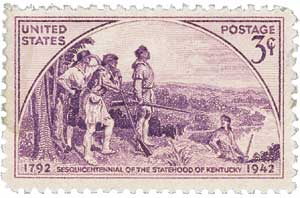
# 904 - 1942 3c Kentucky Statehood
3¢ Kentucky Statehood
City: Frankfort, KY
Quantity: 63,558,400
Printed by: Bureau of Engraving and Printing
Printing Method: Rotary Press
Perforations: 11 x 10.5
Color: Violet
Kentucky Becomes 15th State
Indians lived in the forested areas of western Kentucky many thousands of years ago. When Europeans reached the area there were a number of Indian tribes living there, including the Cherokee, Delaware, Iroquois, and Shawnee.
| Did you know each of these stamps is “clickable?” You can click on each one to learn more about it and buy it for your collection! |
During the late 1600s and early 1700s, many explorers from England and France traveled through the region. The English explorers included Colonel Abraham Wood, Gabriel Arthur, and John P. Salling. Father Jacques Marquette, Louis Jolliet, and Robert Cavelier explored the area for France.
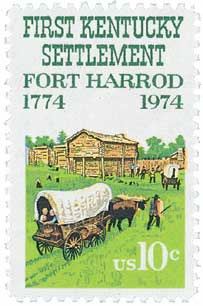
In 1750, Thomas Walker conducted the first extensive European exploration of the eastern portion of Kentucky. The legendary Daniel Boone explored eastern Kentucky in 1767, and again in 1769, when he spent two years living in the Bluegrass region. In 1773, Boone attempted to lead a group of settlers into the area, but Indians prevented it. In 1774, a group of colonists from Pennsylvania, led by James Harrod, established the first permanent white settlement in Kentucky, called Harrodsburg. Soon after, Boone established Boonesborough along the Kentucky River. The route Boone took into Kentucky became known as the “Wilderness Road.”
Separated from the American colonies by mountains and forests, Kentucky was very remote. As the American Revolution raged in the colonies, Kentucky was left susceptible to attacks from Indians who were armed by the British. Under the capable leadership of Boone, Simon Kenton, and George Rogers Clark, the Kentucky settlers were able to defend themselves. In 1776, Kentucky became a county of Virginia. Many settlers from Virginia moved to the area, which prompted an increase in Indian attacks. In 1778, George Rogers Clark led a small group of colonists against the British settlements responsible for supplying arms to the Indians. This action was successful, and greatly reduced the number of attacks against the Kentucky colonists.
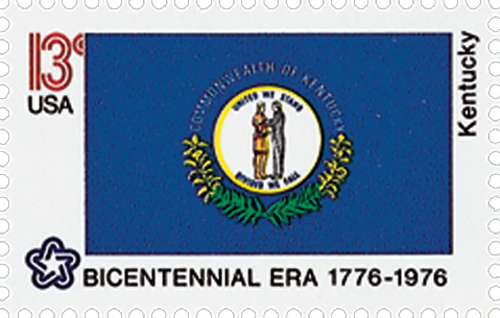
In May 1792, Kentucky adopted a constitution and prepared for statehood, which was achieved June 1, 1792. Isaac Shelby, a hero of the Revolutionary War, helped to frame Kentucky’s constitution and became the state’s first governor.
Most of Kentucky’s settlers were farmers. During the early 1800s, horse breeders began to recognize the superior quality of central Kentucky’s pasturelands. Soon, Kentucky developed a thriving horse-breeding industry.
Farmers benefited greatly from the introduction of steamboats on the Ohio and Mississippi rivers. Steamboats allowed farmers to reach large markets with huge cargoes. Hemp, used for rope making, was among the most important crops. In the mid-1800s, Kentucky produced nearly all the nation’s hemp supply. During the 1830s, tobacco became an important crop, and by the 1860s, Kentucky was the nation’s leading tobacco producer. Farmers also raised corn, rye, and other grains used to make alcoholic beverages. High-quality Kentucky whiskey became a lucrative product.
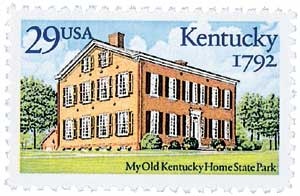
Due to its location and agriculturally based economy, Kentucky had ties to both the North and South. When the Civil War erupted in 1861, Kentucky wished to remain neutral. However, in the summer of 1861, Confederate troops occupied the western portion of the state. In response, Union troops moved into Paducah, a city located in the northwest. By September 1861, the Kentucky legislature created a military force to push the Confederates out of the state. To the Confederacy, this meant Kentucky had sided with the Union. However, many Kentuckians favored the South’s cause.
The war split the state – about 75,000 Kentuckians fought for the Union, while 35,000 fought for the Confederacy. As a result of this division, members of Kentucky families were sometimes pitted against each other on the battlefield.
The conclusion of the Civil War brought economic hardship to Kentucky, with bitter resentment against the North. Slave owners were upset that slaves were freed without payment to the owners. Union soldiers occupied parts of the state long after the war had ended, causing many Kentuckians to feel as though they had been on the losing side of the war.
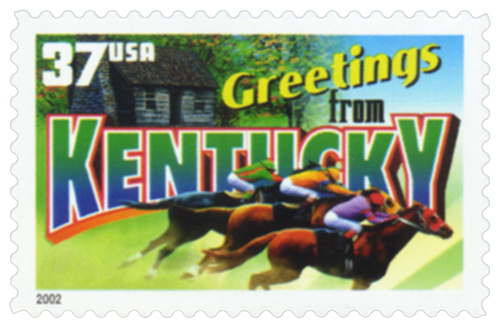
The South’s devastated economy meant less of a market for Kentucky’s products. For example, Kentucky’s hemp crop was used to make rope to bale the South’s cotton. After the war, the cotton crop was greatly reduced. So Kentucky suffered much of the economic depression experienced by the South. One economic boost following the war was the increased interest in horse racing. Many new stables and horse farms were built in Kentucky’s Bluegrass region. The state’s thoroughbred horses became world famous. Also, the spread of railroads stimulated the economy. By the 1890s, the railroads made the eastern part of the state accessible. Mining, coal, oil, and timber production soon became important industries.
Tobacco is grown in nearly every county in Kentucky. However, the tobacco grown in the south and southwestern portion of the state is quite a dark shade. For this reason, those areas are sometimes referred to as the Black Patch. During the late 1800s and early 1900s, a small group of tobacco firms held a monopoly of all the tobacco purchased in Kentucky. This monopoly kept prices low. Farmers from the western part of Kentucky fought this monopoly by burning the warehouses, barns, and fields of farmers who had sold their tobacco to the monopoly. The Black Patch War, as it came to be called, broke the monopoly. Tobacco auctions were established, which assured a fair market for the tobacco farmers.
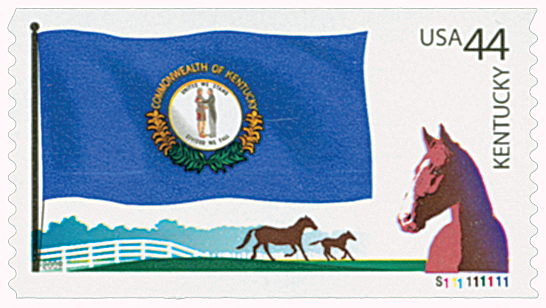
The Great Depression of the 1930s devastated Kentucky’s economy. However, with the start of World War II, the state’s farms and mines became productive again. Tourism, aided by the construction of many new highways, also became lucrative. In 1988, Toyota Motor Corporation opened an auto factory in Georgetown, Kentucky. By 1989, nearly 80 auto parts plants had opened in Kentucky to supply the Toyota factory, as well as factories in other states.
3¢ Kentucky Statehood
City: Frankfort, KY
Quantity: 63,558,400
Printed by: Bureau of Engraving and Printing
Printing Method: Rotary Press
Perforations: 11 x 10.5
Color: Violet
Kentucky Becomes 15th State
Indians lived in the forested areas of western Kentucky many thousands of years ago. When Europeans reached the area there were a number of Indian tribes living there, including the Cherokee, Delaware, Iroquois, and Shawnee.
| Did you know each of these stamps is “clickable?” You can click on each one to learn more about it and buy it for your collection! |
During the late 1600s and early 1700s, many explorers from England and France traveled through the region. The English explorers included Colonel Abraham Wood, Gabriel Arthur, and John P. Salling. Father Jacques Marquette, Louis Jolliet, and Robert Cavelier explored the area for France.

In 1750, Thomas Walker conducted the first extensive European exploration of the eastern portion of Kentucky. The legendary Daniel Boone explored eastern Kentucky in 1767, and again in 1769, when he spent two years living in the Bluegrass region. In 1773, Boone attempted to lead a group of settlers into the area, but Indians prevented it. In 1774, a group of colonists from Pennsylvania, led by James Harrod, established the first permanent white settlement in Kentucky, called Harrodsburg. Soon after, Boone established Boonesborough along the Kentucky River. The route Boone took into Kentucky became known as the “Wilderness Road.”
Separated from the American colonies by mountains and forests, Kentucky was very remote. As the American Revolution raged in the colonies, Kentucky was left susceptible to attacks from Indians who were armed by the British. Under the capable leadership of Boone, Simon Kenton, and George Rogers Clark, the Kentucky settlers were able to defend themselves. In 1776, Kentucky became a county of Virginia. Many settlers from Virginia moved to the area, which prompted an increase in Indian attacks. In 1778, George Rogers Clark led a small group of colonists against the British settlements responsible for supplying arms to the Indians. This action was successful, and greatly reduced the number of attacks against the Kentucky colonists.

In May 1792, Kentucky adopted a constitution and prepared for statehood, which was achieved June 1, 1792. Isaac Shelby, a hero of the Revolutionary War, helped to frame Kentucky’s constitution and became the state’s first governor.
Most of Kentucky’s settlers were farmers. During the early 1800s, horse breeders began to recognize the superior quality of central Kentucky’s pasturelands. Soon, Kentucky developed a thriving horse-breeding industry.
Farmers benefited greatly from the introduction of steamboats on the Ohio and Mississippi rivers. Steamboats allowed farmers to reach large markets with huge cargoes. Hemp, used for rope making, was among the most important crops. In the mid-1800s, Kentucky produced nearly all the nation’s hemp supply. During the 1830s, tobacco became an important crop, and by the 1860s, Kentucky was the nation’s leading tobacco producer. Farmers also raised corn, rye, and other grains used to make alcoholic beverages. High-quality Kentucky whiskey became a lucrative product.

Due to its location and agriculturally based economy, Kentucky had ties to both the North and South. When the Civil War erupted in 1861, Kentucky wished to remain neutral. However, in the summer of 1861, Confederate troops occupied the western portion of the state. In response, Union troops moved into Paducah, a city located in the northwest. By September 1861, the Kentucky legislature created a military force to push the Confederates out of the state. To the Confederacy, this meant Kentucky had sided with the Union. However, many Kentuckians favored the South’s cause.
The war split the state – about 75,000 Kentuckians fought for the Union, while 35,000 fought for the Confederacy. As a result of this division, members of Kentucky families were sometimes pitted against each other on the battlefield.
The conclusion of the Civil War brought economic hardship to Kentucky, with bitter resentment against the North. Slave owners were upset that slaves were freed without payment to the owners. Union soldiers occupied parts of the state long after the war had ended, causing many Kentuckians to feel as though they had been on the losing side of the war.

The South’s devastated economy meant less of a market for Kentucky’s products. For example, Kentucky’s hemp crop was used to make rope to bale the South’s cotton. After the war, the cotton crop was greatly reduced. So Kentucky suffered much of the economic depression experienced by the South. One economic boost following the war was the increased interest in horse racing. Many new stables and horse farms were built in Kentucky’s Bluegrass region. The state’s thoroughbred horses became world famous. Also, the spread of railroads stimulated the economy. By the 1890s, the railroads made the eastern part of the state accessible. Mining, coal, oil, and timber production soon became important industries.
Tobacco is grown in nearly every county in Kentucky. However, the tobacco grown in the south and southwestern portion of the state is quite a dark shade. For this reason, those areas are sometimes referred to as the Black Patch. During the late 1800s and early 1900s, a small group of tobacco firms held a monopoly of all the tobacco purchased in Kentucky. This monopoly kept prices low. Farmers from the western part of Kentucky fought this monopoly by burning the warehouses, barns, and fields of farmers who had sold their tobacco to the monopoly. The Black Patch War, as it came to be called, broke the monopoly. Tobacco auctions were established, which assured a fair market for the tobacco farmers.

The Great Depression of the 1930s devastated Kentucky’s economy. However, with the start of World War II, the state’s farms and mines became productive again. Tourism, aided by the construction of many new highways, also became lucrative. In 1988, Toyota Motor Corporation opened an auto factory in Georgetown, Kentucky. By 1989, nearly 80 auto parts plants had opened in Kentucky to supply the Toyota factory, as well as factories in other states.








